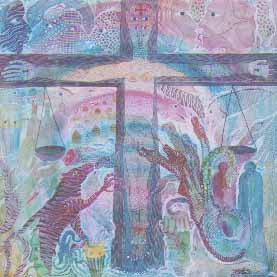|
|
This is an especially good Zephirin. The palate is pastel, the style is misty and transparent with figures emerging from the haze to play their parts. It's a painting that summons you from across the room and draws you closer, revealing more and more details as you come closer.
The crucified figure has 3 heads and 3 feet, to symbolize the Trinity. One of the hands is human,  the other the claw of an animal, representing the duality of life forms. Zephirin explains that sometimes men act like animals while animals, at times, behave more rationally than do humans. the other the claw of an animal, representing the duality of life forms. Zephirin explains that sometimes men act like animals while animals, at times, behave more rationally than do humans.
On the forehead of the Trinity is painted the red cross of evangelization (Detail 1 below). Zephirin explains that if you want to oppress people, one of the best ways is to do it in the name of god. The body is also adorned with spirals which represent the unpredictability of life.
Below the cross on the left ( Detail 2 below) are the three spirits of Colonization, the Pope, the King and the Bishop. The Pope and the Bishop are pushing the king to the front so that the state, not the church, is blamed for the colonization. To their left is the cemetary of the Dictators. Below is a drum with a torn head which indicates that the colonizer must break the culture of the oppressed and impoverish them to the point that they must beg for justice as represented by the supplicating hands below the left hand scale of justice. Farther below, (Detail 3) the red and black striped stallion of revolution has emerged from the drum and is conversing with his allies, including the "loa" or spirits of vodou who are represented here by the blue-faced Bossou. (Everybody knows that one must have horns to be a revolutionary.) The green face is the face of treason, it's forked tongue represents the duplicity and dishonesty of politicians.
Below the cross on the right, ( Detail 4) the situation has changed. The hands that had formerly been begging for justice are now poised to take it by force; the colonizers have been dethroned and are now praying for their own survival. The drum to the right of the cross is adorned with a map of the world and the star of hope which will guide the revolutionaries to freedom. The head of this drum is intact and can still be played; it is the drum of freedom. The point of the painting, according to Zephirin, is that those in power will never willingly dispense justice: it must be taken by those who desire it. |